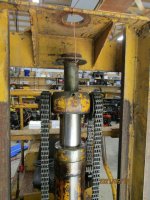Steve Marquess
Cast Iron
- Joined
- Jan 14, 2007
- Location
- Adamstown, Maryland USA
Time to tap the PM braintrust again. After replacing a blown hose, and a couple that were about to go, in my vintage forklift I decided I'd have a crack at putting new seals in the lift cylinder before cleaning up.
It's a displacement cylinder so I'm thinking I should be able to unscrew the gland nut without pulling the cylinder from the mast (and incredibly two of the gland nut spanner holes aren't buggered up!).
The roller chain yoke sitting on top of the ram has two setscrews. That yoke is mostly hollow with only about a 3/4" thick bore sitting on a shoulder on the top of the ram. A guide tube (hanging from copper wire in photo) slides inside of the yoke and ram:

When I separated the cylinder from the yoke I found that the guide tube won't lift out of the yoke/ram. I also found that the two setscrews in the yoke were a good 1/2" shy of actually touching the ram. The threaded setscrew holes go all the way through the yoke and halfway into the turned down hollow ram. The guide tube rides in a brass guide inside the ram; doesn't look threaded and there are no spanner holes or slots. Everything of course has been thoroughly massaged with hammers in years past.

With the two setscrews out I figured the yoke would just be sitting on the ram shoulder, but it doesn't want to move even with encouragement from a large brass hammer. Trying to move it only moves the entire ram.
Any suggestions? My next idea is to fabricate some spacers and use a porta-power to press the yoke off the ram, but that had better uncover some means of freeing the guide tube. Since I can afford to let this sit for a few days I thought I'd try for a sanity check before escalating the violence.
It's a displacement cylinder so I'm thinking I should be able to unscrew the gland nut without pulling the cylinder from the mast (and incredibly two of the gland nut spanner holes aren't buggered up!).
The roller chain yoke sitting on top of the ram has two setscrews. That yoke is mostly hollow with only about a 3/4" thick bore sitting on a shoulder on the top of the ram. A guide tube (hanging from copper wire in photo) slides inside of the yoke and ram:

When I separated the cylinder from the yoke I found that the guide tube won't lift out of the yoke/ram. I also found that the two setscrews in the yoke were a good 1/2" shy of actually touching the ram. The threaded setscrew holes go all the way through the yoke and halfway into the turned down hollow ram. The guide tube rides in a brass guide inside the ram; doesn't look threaded and there are no spanner holes or slots. Everything of course has been thoroughly massaged with hammers in years past.

With the two setscrews out I figured the yoke would just be sitting on the ram shoulder, but it doesn't want to move even with encouragement from a large brass hammer. Trying to move it only moves the entire ram.
Any suggestions? My next idea is to fabricate some spacers and use a porta-power to press the yoke off the ram, but that had better uncover some means of freeing the guide tube. Since I can afford to let this sit for a few days I thought I'd try for a sanity check before escalating the violence.






